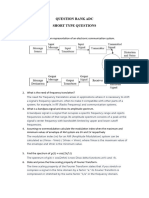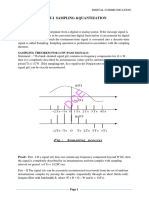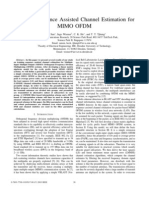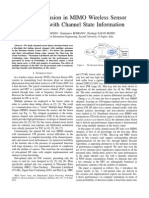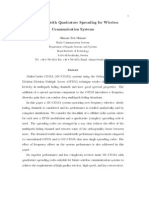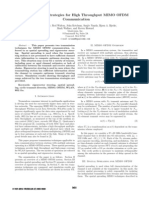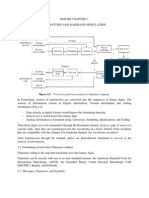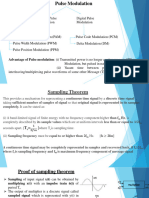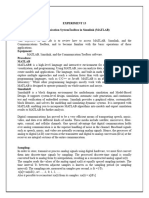Digital Communication Systems
Uploaded by
Vijay KumarDigital Communication Systems
Uploaded by
Vijay KumarCommunication Systems II Dr. Wail A.H.
Hadi
1
Digital Communication Systems
The term digital communication covers a broad area of
communications techniques, including digital transmission and digital
radio.
Digital transmission, is the transmitted of digital pulses between
two or more points in a communication system.
Digital radio, is the transmitted of digital modulated analog
carriers between two or more points in a communication system.
Why Digital
There are many reasons
- The primary advantage is the ease with which digital signals,
compared to analog signal, are regenerative.
The shape of the waveform is affected by two mechanisms:
(1) As all the transmission lines and circuits have some nonideal
transfer function, there is a distorting effect on the ideal pulse.
(2) Unwanted electrical noise or other interference further distorts the
pulse waveform.
Both of these mechanisms cause the pulse shape to degrade as a
function of distance.
During the time that the transmitted pulse can still be reliably
identified, the pulse is thus regenerated. The circuit that perform this
function at regular intervals along a transmission system are called
regenerative repeaters.
Communication Systems II Dr. Wail A.H. Hadi
2
- Digital circuits are less subject to distortion and interference than
analog circuits.
- Digital circuits are more reliable and can be produced at lower cost
than analog circuits. Also, digital hardware lends itself to more
flexible implementation than analog hardware.
- Digital techniques lend themselves naturally to signal processing
functions that protect against interference and jamming.
- Much data communication is computer to computer, or digital
instrument or terminal to computer. Such digital terminations are
naturally best served by digital link.
Communication System Models
Generally, there are two types for communication system models,
base-band model and pass-band model.
In base-band model, the spectrum of signal from zero to some
frequency (i.e. carrier frequency=0). For transmission of base-band
signal by a digital communication system, the information is formatted
so that it is represented by digital symbols. Then, pulse waveforms are
assigned that represented these symbols. This step referred to as pulse
modulation or base-band modulation. These waveforms can be
transmitted over a cable. Base-band signal also called low-pass signal.
In pass-band (or band-pass) signal, the signal has a spectral
magnitude that is nonzero for frequency in some band concentrate
about a frequency
C
f f = and negligible elsewhere, where f
c
is the
carrier frequency need to be much greater than zero. For radio
Communication Systems II Dr. Wail A.H. Hadi
3
transmission the carrier is covered to an electromagnetic (EM) filed for
propagation to desired destination.
Multiplexing
Multiplexing is the transmission of information (either voice or
data) from more than one source to more than one destination on the
same transmission medium.
Two most common methods are used, frequency division
multiplexing (FDM) and time division multiplexing (TDM).
- FDM
In FDM multiple sources that originally occupied the same
frequency spectrum are each converted to a different frequency band
and transmitted simultaneously over a single transmission medium.
FDM is an analog multiplexing scheme. Figure below shows the
frequency-time plane.
Communication Systems II Dr. Wail A.H. Hadi
4
If two input signals to a mixer are sinusoids with frequencies f
A
and f
B
, the mixing or multiplication will yield new sum and difference
frequencies at f
A+B
and f
A-B
. Equation below describes the effect of the
mixer.
)] cos( ) [cos(
2
1
cos cos B A B A B A + + =
A simple FDM example with three translated voice channels is shown
in figure below.
Communication Systems II Dr. Wail A.H. Hadi
5
- TDM
With TDM system, transmission from multiple sources occurs on
the same transmission medium but not at the same time. Transmission
from various sources is interleaved in time domain.
Figure below shows the time-frequency plan in TDM system, the
same communication resources is shared by assigning each of N
symbols or users the full spectral occupancy of the system for a short
duration of time called time slot. The unused time regions between slot
assignments, called guard times, act as buffer zone to reduce
interference.
Figure below shows a typical TDM system: -
Communication Systems II Dr. Wail A.H. Hadi
6
The multiplexing operation consists of providing each source
with an opportunity to occupy one or more slots. The demultiplexing
operation consists of desloting the information and delivering the data
to the intended sink.
The communication switches (S
1
S
M
) have synchronized so that
the massage corresponding to signal(1), for example, appears on the
channel (1) output, and so on.
Time is segmented in to intervals called frames. Each frame is
further partitioned in to assignable user time slots.
The simplest TDM scheme called fixed-assignment TDM. In
fixed assignment TDM scheme, all of the slot has no data to sent during
a particular frame, that slot is wasted.
Another more efficient scheme, involving the dynamic
assignment of the slots rather than fixed assignment.
Figure below shows the fixed assignment TDM system.
Figure below shows the fixed assignment and dynamic
assignment TDM system.
Communication Systems II Dr. Wail A.H. Hadi
7
Sampling Theorem
The link between an analog waveform and its sampled version is
provided by what is known as the sampling process.
A band limited signal having no spectral components above (f
m
Hz) can be determined uniquely by values sampled at uniform intervals
of T
s
second, where
m
s
f
T
2
1
s
Stated another way, the upper limit on T
s
can be expressed in
terms of the sampling rate, denoted
s
s
T
f
1
=
Communication Systems II Dr. Wail A.H. Hadi
8
The restriction, stated in terms of sampling rate, is known as the
Nyquist criterion. The statement is
m s
f f 2 >
The sampling rate (
m s
f f 2 =
) also called Nyquist rate.
The Nyquist criterion is a theoretically sufficient condition to
allow an analog signal to be reconstructed completely from a set of
uniformly spaced discrete time samples.
Impulse Sampling
Assume an analog waveform x(t), as shown in Fig. (a), with a
Fourier transform, X(f), which is zero outside the interval (-f
m
<f<f
m
), as
shown in Fig. (b). The sampling of x(t) can be viewed as the product of
x(t) with a train of unit impulses functions, x
s
(t), shown in Fig. (c), and
defined as follows:
=
=
n
s
nT t t x ) ( ) (
Let us choose
m
s
f
T
2
1
= , so that Nyquist rate is just satisfied.
Using shifting property of the impulse function the x
s
(t), shown
in Fig. (e), can be given by
=
= =
n
s s
nT t t x t x t x t x ) ( ) ( ) ( ) ( ) (
Communication Systems II Dr. Wail A.H. Hadi
9
=
=
n
s s
nT t nT x ) ( ) (
Using frequency convolution property of Fourier transform, the
time product
) ( ) ( t x t x
transforms to the frequency domain
convolution ) ( ) ( f X f X
, where ) ( f X
is the Fourier transform of
) (t x
and given by
=
=
n
s
s
nf f
T
f X ) (
1
) (
The convolution with an impulse function simply shifts the
original function, as follows:
) ( ) ( ) (
s s
nf f X nf f f X =
The Fourier transform of the sampled waveform, X
s
(f), can be
given by:
=
= =
n
s
s
s
nf f
T
f X f X f X f X )] (
1
[ ) ( ) ( ) ( ) (
=
=
n
s
s
nf f X
T
) (
1
Figure below shows the sampling theorem using the frequency
convolution property of the Fourier transform (Impulse sampling).
Communication Systems II Dr. Wail A.H. Hadi
10
Natural Sampling
In this way the band limited analog signal x(t), shown in Fig. (a
1
),
is multiplied by the pulse train or switching waveform x
p
(t), shown in
Fig. (c
1
). Each pulse in x
p
(t) has width T and amplitude 1/T.
The resulting sampled data sequence, x
s
(t), is shown in Fig. (e
1
)
and is expressed as
) ( ) ( ) ( t x t x t x
p s
=
The periodic pulse train, x
p
(t), can be expressed as a Fourier
series in the form
Communication Systems II Dr. Wail A.H. Hadi
11
=
=
n
t nf j
n p
s
e c t x
2
) (
and
) ( sin
1
s s
n
T
nT
c
T
c =
where f
s
=2f
m
, T is the pulse width, and 1/T is the pulse amplitude.
The envelope of magnitude spectrum of the pulse train, seen as a
dashed line in Fig. (d
1
), has characteristic sinc shape.
=
=
n
t nf j
n s
s
e c t x t x
2
) ( ) (
The Fourier transform of x
s
(t) is found as follows
] ) ( [ ) (
2
=
=
n
t nf j
n s
s
e c t x F f X
For linear system the operation of summation and Fourier
transformation can be interchanged. Therefore,
] ) ( [ ) (
2
=
=
n
t nf j
n s
s
e t x F c f X
Using frequency translation property of Fourier transform,
=
=
n
s n s
nf f X c f X ) ( ) (
Note
The sampling here is termed natural sampling, since the top of
each pulse in the x
s
(t) sequence retains the shape of its corresponding
analog segment during the pulse interval.
Communication Systems II Dr. Wail A.H. Hadi
12
Figure below shows the sampling theorem using the shifting
property of the Fourier transform (Natural sampling).
Communication Systems II Dr. Wail A.H. Hadi
13
Pulse Modulation
In pulse modulation some parameter of a pulse train is varied in
accordance with the massage signal.
Two families of pulse modulation may be distinguished: analog
pulse modulation and digital pulse modulation. In analog pulse
modulation, a periodic pulse train is used as the carrier wave, and some
characteristics features of each pulse (e.g. Amplitude, Position, and
Width) is varied in a continuous manner in accordance with the
corresponding sample value of the message signal. Thus in analog
pulse modulation, information is transmitted basically in analog form,
but the transmission takes place at discrete times.
In digital pulse modulation, on the other hand, the massage signal
is represented in a form that is discrete in both time and amplitude;
thereby permitting its transmission in digital form as a sequence of
coded pulses.
(1) Pulse Amplitude Modulation (PAM)
PAM is the simplest and most basic form of analog pulse
modulation. In PAM the amplitude of regularly spaced pulses are
varied in proportion to the corresponding sample values of a continuous
message signal, the pulses can be of a rectangular form or other
appropriate shape.
PAM as defined here is somewhat similar to natural sampling
where the message signal is multiplied by a periodic train of
rectangular pulses. However, in natural sampling the top of each
Communication Systems II Dr. Wail A.H. Hadi
14
modulated rectangular pulse varies with the message signal, whereas in
PAM it is maintained flat.
The waveform of PAM signal is shown in figure below.
There are two operations involved in the generation of the PAM
signal:-
(i) Instantaneous sampling of the message signal every Ts second,
where the sampling rate f
s
=1/T
s
is chosen in accordance with the
sampling theorem.
(ii) Lengthening the duration of each sample so obtained to some
constant value (
).
Communication Systems II Dr. Wail A.H. Hadi
15
PAM/TDM System
Suppose we wish to time multiplexed two signals using PAM.
Let us assume that both input signal f
1
(t) and f
2
(t) are low pass, and
band limited to 3KHz. The sampling theorem states that each must be
sampled at a rate no less than 6KHz. This requires a 12KHz minimum
clock rate for the two channel system. Figure below shows the block
diagram of PAM/TDM system.
The time multiplex PAM output might appear some thing like
that shown below.
Communication Systems II Dr. Wail A.H. Hadi
16
The time spacing between adjacent samples in the time multiplex
signal waveform (T
x
), can be defined as
n
T
T
s
x
=
where T
s
=sampling rate, and n=number of input signals.
To prevent any irretrievable loss of information in the composite
waveform then requires that bandwidth B
x
of LPF must satisfy the
criterion
x
x
T
B
2
1
>
At the receiver the composite time multiplexed and filtered
waveform must be resampled and separated into the appropriate
channel. One the pulses are separated, the normal sampling
considerations applies and the analog reconstruction of signals can be
obtained by LPF. The block diagram of PAM/TDM receiver is shown
below.
Communication Systems II Dr. Wail A.H. Hadi
17
Sample and Hold Circuit
Figure below shows the sample and hold circuit
The switch closes only when that particular channel is to be
sampled. If the source impedance r is small, the capacitor voltage
changes to the input voltage within the time
that switch is closed.
The load impedance R is arranged to be high so that the capacitor
retains the voltage level until the switch is closed again. Therefore the
sample and hold circuit accepts only those values of the input which
occur at the sampling times and then holds them until the next sampling
time.
Example:
Channel 1 of two channels PAM system handles 8KHz signal.
Channel 2 handles 10 KHz signals. The two channels are sampled at
equal intervals of time using very narrow pulses at the lowest frequency
that is theoretical adequate. The sampled signals are time multiplexed
and passed through a LPF before transmission.
Communication Systems II Dr. Wail A.H. Hadi
18
(1) What is the minimum clock frequency of the PAM system?
(2) What is the minimum cut off frequency of LPF used before
transmission that will preserve the amplitude information on the
output pulses?
(3) What would be the minimum bandwidth if these channels were
frequency multiplexed, using AM technique and SSB technique?
Solution
(1)
KHz f
f f
s
m s
16 8 * 2
* 2
1
1 1
= =
=
KHz f
f f
s
m s
20 10 * 2
* 2
2
2 2
= =
=
In order to sample channel 2 adequately
KHz f f
s s
20
2
= =
The minimum clock rate
s
f n* =
KHz 40 20 * 2 = =
(2)
KHz B
T
B
n
T
T
n
KHz f
T
x
x
x
s
x
s
s
20
2
1
sec 25
2
50
2
sec 50
20
1 1
=
>
= = =
=
= = =
Communication Systems II Dr. Wail A.H. Hadi
19
(4) For AM
KHz f f BW
m m
36 ) 10 8 ( 2 ) ( 2 . . min
2 1
= + = + =
For SSB
KHz f f BW
m m
18 10 8 . . min
2 1
= + = + =
H.W
Two low pass signals, each band limited 4KHz, are to be time
multiplexed into a single channel using PAM. Each signal is impulse
sampled at a rate 10KHz. The time multiplexed signal waveform is
filtered by an ideal LPF before transmission.
(a) What is minimum clock frequency of the system?
(b) What is the minimum cut off frequency of the LPF?
(c) In the receiver side, determine the minimum and maximum
acceptable bandwidth of the LPF used in retrieving the analog
signal?
Ans. (a) 20KHz (b) 10KHz (c) 4KHz, 6KHz.
Communication Systems II Dr. Wail A.H. Hadi
20
(2) Other Types of Analog Pulse Modulation (PWM&PPM)
One type of pulse timing modulation uses constant amplitude
pulses whose width is proportional to the value of message signal at the
sampling instants. This type is designated as pulse width modulation
(PWM) or pulse duration modulation (PDM) is also called.
Another possibility is to keep both the amplitude and the width of
the pulses constant but vary the pulse position in proportion to the
value of message signal at sampling instant. This is designated as pulse
position modulation (PPM).
PAM, PWM and PPM waveforms for a given message signal are
shown below: -
In PWM, the signal f(t) is sampled periodically at a rate fast
enough to satisfy the requirements of the sampling theorem. At each
sampling instant a pulse is generated with fixed amplitude and a width
Communication Systems II Dr. Wail A.H. Hadi
21
that is proportional to the sample value of f(t). A minimum pulse width
is assigned to the minimum value of f(t).
In PPM, these are sent as constant width, constant amplitude
pulses. The minimum pulse delay is used to designate the minimum
value of f(t) and the change in delay is proportional to the modulating
signal. The constant of proportionality is the modulation constant.
Generation of PWM & PPM
Generation of PWM and PPM commonly employs various
combinations of a sample and holed circuit, a precision ramp voltage
generator and a comparator. The block diagram of a typical circuit for
generation PWM and PPM is shown in figure below: -
Communication Systems II Dr. Wail A.H. Hadi
22
The ramp generator produces a precision ramp voltage which has
peak to peak amplitude slightly larger than the maximum amplitude
range of the input signals. This ramp voltage is the basis for the
amplitude to timing conversion and therefore must be accurately
known.
The comparator is a high gain amplifier intended for two stated
operation. If input signal is higher than a preset reference level, the
output is held in one state (i.e. a given voltage level). Whenever the
input signal level is less than the reference level, the output is held in
the other state. Which output state is present, then, depends upon
whether the input is above and below the threshold (reference level) of
the comparator.
The voltage reference level of the comparator is adjust so that
there is always an intersection with the sum of the sample and hold
circuit and ramp voltage. In this system, the first crossing of the
reference level indicates the clock timing and the second crossing
generates the variable trailing edge.
A convenient way to generate PPM is to use PWM waveform
generated above and then trigger a constant width pulse generation
those edge of the PWM waveform with a negative slope.
Communication Systems II Dr. Wail A.H. Hadi
23
Signal to noise ratio in analog pulse modulation
The performance of analog pulse modulation system in the
presence of additive noise is investigated here.
- PAM
Noise is added in the transmission of the PAM signal as
illustration in figure below.
The noise occurring between pulses adds noise power to the
transmission without any increase in signal power. To avoid this, a
synchronized gating circuit is used in the receiver to accept samples
only when the signal is known to be present.
We shall assume that the signal and the additive noise present in
the input to the PAM receiver are band limited and that the conditions
of the sampling theorem are satisfied. Because the PAM receiver is
linear, we can apply the signal and the noise separately measures their
power, and then combine. The sampling and low pass filtering at the
receiver reproduce the band limited signal and noise spectra within a
constant, as shown in figure below.
Communication Systems II Dr. Wail A.H. Hadi
24
Thus
) ( ) (
2 2
0
t S K t S
i
=
) ( ) (
2 2
0
t n K t n
i
=
So that
i
i
N
S
N
S
=
0
0
- Pulse timing modulation
Although the pulses to convey the information may be generated
with extremely short (fast) rise time, after passing through a band
limited system they have rise time which are governed by the
bandwidth of the system. This rise time can be approximated by a
linear ramp. As shown in figure below, so that the pulse assumes a
trapezoidal shape.
The position of the trapezoidal pulse is sensitive to additive
noise. If the noise voltage is assumed to vary slowly compared to the
rise time of the pulse, the variation in the pulse amplitude, n, may be
Communication Systems II Dr. Wail A.H. Hadi
25
represented by a shift,
, in the pulse position as shown in above
figure.
From the geometry of above figure, we have
A
n
t
r
=
or
2 2 2
) ( n
A
t
r
=
(1)
The output signal amplitude is proportional to the modulating
signal f(t) through a modulation constant k.
) ( ) (
0
t kf t S =
or
) ( ) (
2 2 2
0
t f k t S =
(2)
The output noise use Eq.(1)
) ( ) (
2 2 2 2
0
t n
A
t
n
i
r
= =
(3)
Also we have
) (
2 2
s
i
T
A S
=
(4)
and for ideal LPF (giving a nearly linear rise time)
r
t
B
1
=
(5)
Communication Systems II Dr. Wail A.H. Hadi
26
Combining Eqs. (2) and (5) we have
i
i
N
S
B
T
t f K
N
S
2
2 2
0
0
/
) (
=
i
i
N
S
B
N
S
2
0
0
the S/N improvement in a PPM is proportional to the square of the
bandwidth.
Pulse code modulation (PCM)
Pulse code modulation (PCM) is the name given to the class of
baseband signals obtained from the quantized PAM signals by encoding
each quantized sample into a digital word. Figure below shows the steps
required in PCM communication.
The source of information is sampled and quantized to one of L-
levels, then each quantized sample is digitally encoded into a k-bits
code word.
Where
L k
2
log =
k
L 2 =
The essential features of binary PCM are shown in figure below.
Assume that an analog signal, x(t), is limited in its excursions to the
PCM signal PAM signal
Input signal
Sampler Quantizer Encoder
Communication Systems II Dr. Wail A.H. Hadi
27
range (-4V to +4V). The step size between quantization levels has been
set at 1V. Thus eight quantization level are employed, these located at
-3.5V, -2.5V, ., +3.5V.
The code number 0 may be assigned to the level at -3.5V; the code
number 1 may be assigned to the level at -2.5V, and so on until the level
at 3.5V, which is assigned the code number 7.
Each code number has its representation in binary arithmetic,
ranging from 000 for code number 0 to 111 for code number 7.
Communication Systems II Dr. Wail A.H. Hadi
28
From the above figure each sample of analog signal is assigned to
the quantization level closest to the value of the sample. Beneath the
analog waveform, x(t), are seen four representations of x(t) as follows:-
the natural sample value, the quantized sample value, the code numbers,
and the PCM sequence.
Quantization
The objective of the quantization step in PCM process is to represent
each sample by a fixed number of bits.
For example, if the amplitude of PAM resulting from sampling
process ranges between (-1V and +1V), there can be infinite values of
voltage between (-1 and +1). For instance, one value can be -0.27689V.
To assign a different binary sequence to each voltage value, we would
have to construct a code of infinite length. Therefore, we can take a
limit number of voltage values between (-1V and +1V) to represent the
original signal and these values must be discrete.
Assume that the quantization steps were in 0.1V increment, and the
voltage measurement for one sample is 0,58V. That would have to be
rounded off to 0.6V, the nearest discrete value. Note that there is a
0.02V error, the difference between 0.58V and 0.6V. See figure below.
Take step 12 in the curve, for example, the curve is passing through a
maximum and is given tow values of 12. For the first value, the actual
curve is above 12 and for second value below 12. That error from the
true value to the quantum value is called quantization distortion. This
distortion is the major source of imperfection in PCM system.
Communication Systems II Dr. Wail A.H. Hadi
29
The more quantization level, the better quality the system will
deliver. However, increasing the number of quantization level has two
major costs:-
1) The cost of designing a system with large binary code size needed.
2) The time it takes to process this large number of quantizing steps by
the coder.
Therefore, a very large number of quantizing levels may induce
unwanted delays in the system.
15
12
1
0
12 12
+1
-1
0
Code value
Communication Systems II Dr. Wail A.H. Hadi
30
Uniform and Nonuniform Quantization
Form the above discussion it cam be seen that the quantization noise
depends on the step size. When the steps have uniform size the
quantization called as uniform quantization.
For uniform quantization, the quantization noise is the same for all
signal magnitudes. Therefore, with uniform quantization the signal to
noise ratio (SNR) is worse for low level signals than for high level
signals.
Nonuniform quantization can provide fine quantization of the weak
signal and coarse quantization of the strong signal. Thus in the case of
nonuniform quantization, quantization noise can be made proportional
to signal size. The effect is to improve the overall SNR by reducing the
noise for the predominant weak signals, at the expense of an increase in
noise for the rarely occurring strong signals. Figure below compares the
quantization of strong signal versus a weak signal for uniform and
nonuniform quantization.
Communication Systems II Dr. Wail A.H. Hadi
31
Encoding
Figure below some of the more commonly used PCM
representation.
1) Return-to-zero (RZ) method represents a 1 by a change to the
level for one-half the bit interval, after which the signal returns to
the reference level for the remaining half-bit interval. A 0 is
indicated in this method by no change, the signal remaining at the
reference level.
Communication Systems II Dr. Wail A.H. Hadi
32
2) Return-to-bias (RB) method, in this method three levels are used
0, 1, and a bias level. The bias level may be chosen either below
or between the other two levels. The waveform returns to the bias
level during the last half of each bit interval.
3) Alternate Mark Inversion (AMI), in this method the first binary
one is represented by +1, the second by -1, the third by +1, etc.
The AMI representation is easily derived from an RZ binary code
(and vice versa) by alternately inverting the 1s. It has zero
average value and is widely used in telephone PCM systems.
This is also referred to as a bipolar return-to-zero (BRZ)
representation.
4) Split-phase representations eliminate the variation in average
value using symmetry. In the Manchester split-phase method, a 1
is represented by a 1 level during the first half-bit interval, then
shifted to the 0 level for the latter half-bit interval; a 0 is
indicated by the reverse representation. In the split-phase (mark)
method, a similar symmetric representation is used expect that a
phase reversal relative to the previous phase indicates a 1 (i.e.
mark) and no change in phase is used to indicate a 0.
5) Nonreturn-to-zero (NRZ) representations reduce the bandwidth
needed to send PCM code. In NRZ (L) representations a bit pulse
remains in one of its two levels for the entire bit interval. In NRZ
Communication Systems II Dr. Wail A.H. Hadi
33
(M) method a level change is used to indicate a mark (i.e a 1) and
no level change for a 0; the NRZ (S) method uses the same
scheme except that a level change is used to indicate a space (i.e.
a 0). Both of these are examples of the more general
classification NRZ (I) in which a level change (inversion) is used
to indicate one kind of binary digit and no level change indicates
the other digit. Note that use of split-phase and NRZ
representations require some added receiver complexity to
determine the clock frequency.
6) Delay modulation (Miller code), in this method a 1 is
represented by a signal transition at the midpoint of a bit interval.
A 0 is represented by no transition unless it is followed by
another 0, in which case the signal transition occurs at the end of
the bit interval. In this method, a succession of 1s and a
succession of 0s each are represented by a square wave at the bit
rate, but one is delayed a half-bit interval from the other.
Noise consideration in PCM system
The performance of a PCM system is influenced by two major
sources of noise.
1) Channel noise, which is introduced anywhere between the
transmitter output and the receiver input, channel noise is always
present, once the equipment is switched on.
Communication Systems II Dr. Wail A.H. Hadi
34
2) Quantization noise, which is introduced in the transmitter and is
carried all the way along to the receiver output.
Quantization Noise
The peak signal to r.m.s noise power ratio is given by
2
0
0
3L
N
S
=
L
N
S
dB 10
0
0
log 20 8 . 4 ) + =
where L=number of quantizer level.
S
0
= peak signal power.
N
0
= r.m.s noise power.
Increasing L increases the number of code pulses and hence the
bandwidth. We can thus relate SNR to bandwidth. This is easily done
by noting that
m
n L =
where m=the number pulses in code group.
n=the number of code levels.
m
n
N
S
2
0
0
3 =
and
n m
N
S
dB 10
0
0
log 20 8 . 4 ) + =
Communication Systems II Dr. Wail A.H. Hadi
35
In particular, for binary code n=2.
m
N
S
dB
6 8 . 4 )
0
0
+ =
Since the bandwidth is proportional to m, the output SNR increases
exponentially with bandwidth.
Intersymbol interference (ISI) and pulse shaping to reduce ISI
Consider the sequence of pulses shown in figure below. Although
these are shown as binary pulses, they could well be pulses of identical
shape, but of arbitrary height. They are shown recurring at T
s
second,
where T
s
is the sampling interval.
System filtering causes these pulses to spread out as they traverse
the system. And they overlap into adjacent time slot as shown. At the
receiver the original pulse message may be derived by sampling at the
center of each time slot, and then basing a decision on the amplitude of
the signal measured at that point.
Communication Systems II Dr. Wail A.H. Hadi
36
The signal overlapped into adjacent time slots may, if too strong,
results in an erroneous decision. Thus, as an example, in the case of
above figure the 0 transmitted may appear as a 1 if tails of adjacent
pulses add up to too high a value.
This phenomenon of pulse overlap and the resultant difficulty
with receiver decision is termed intersymbol interference (ISI).
Nyquist investigated the problem of specifying a received pulse
shape so that no ISI occurs at the detector. He showed that the
theoretical minimum system bandwidth needed to detect R
s
symbol/second without ISI is R
s
/2 Hz. This occurs when the system
transfer function, H(f), is made rectangular as shown in figure below.
Communication Systems II Dr. Wail A.H. Hadi
37
Note that, when H(f) is such an ideal filter with bandwidth 1/2T,
its impulse response
) ( sin ) (
T
t
c t h =
Therefore, the bandwidth required to detect 1/T symbol/sec. is
1/2T Hz.
The Nyquist pulse shape is not physically realizable since it
dictates a rectangular bandwidth characteristic. Also, with such a
characteristic, the detection process would be very sensitive to small
timing error.
One frequently used system transfer function H(f) is called the
raised cosine filter. It can be expressed as
+
+ =
0
)]
2
] 1 ) 2 [(
cos( 1 [
2
1
1
) (
r
r f T
f H
T
r
f
T
r
f
T
r
T
r
f
2
1
2
1
2
1
2
1
0
+
>
+
s <
s s
where
0
0
= r
is called roll-off factor.
= absolute bandwidth.
T 2
1
0
=
=minimum Nyquist bandwidth.
Communication Systems II Dr. Wail A.H. Hadi
38
Therefore, the bandwidth may be given by:-
T
r
W B
2
) 1 (
.
+
=
Note:-
- If
0
0 = = r
, is the Nyquist minimum bandwidth.
- If
T
r
1
2 0
0
= = =
.
The corresponding impulse response for the H(f) of raised cosine
filter is:-
)
)
2
4
( 1
cos
( )
sin
( ) (
2
T
rt
T
rt
T
t
T
t
t h
Figure below shows the raised cosine filter characteristics.
Communication Systems II Dr. Wail A.H. Hadi
39
Communication Systems II Dr. Wail A.H. Hadi
40
Channel Capacity
The maximum rate of transmission was found by Shannon to be
given by:-
) 1 ( log
2
N
S
W C + =
Shannons maximum capacity expression provides an upper bound on
the rate at which one can communicate over a channel of bandwidth W,
and signal to noise ratio SNR (
N
S
).
Delta modulation (DM)
In the basic form, DM provides a stair case approximation to the
over sampled version of the message signal, as shown in figure below,
the difference between the input and the approximation is quantized into
only two levels, namely, A , corresponding to positive and negative
differences, respectively. Thus, if the approximation below the signal at
any sampling epoch, it is increased by A, on the other hand, the
approximation lies above the signal, it is diminished by A.
Communication Systems II Dr. Wail A.H. Hadi
41
Denoting the input signal as m(t), and its stair case approximation as
m
q
(t), the basic principle of DM may be formalized in the following set
of discrete time relations:-
) ( ) ( ) (
s s q s s
T nT m nT m nT e =
(a)
)] ( [ ) (
s s q
nT e Sgn nT e A =
(b)
) ( ) ( ) (
s q s s q s q
nT e T nT m nT m + =
(c)
where
T
s
=sampling time, e(nT
s
)=error signal representing difference between
m(nT
s
) and the latest approximation to it m(nT
s
)-m
q
(nT
s
-T
s
), e
q
(nT
s
)=
the quantized version of e(nT
s
).
Finally, the quantizer output e
q
(nT
s
) coded to produce the DM
signal.
DM modulator and demodulator are shown below.
Communication Systems II Dr. Wail A.H. Hadi
42
The comparator computes the difference between two inputs. The
quantizer consists of hard limiter with an input/output relation that is
scaled version of the signum function. The accumulator increments the
approximation by a stepAin positive or negative direction, depending
on the algebraic sign of the error signal e(nT
s
).
Demodulation is subjected to two types of error:-
(1) Slop over load direction.
(2) Granular noise.
Equation (c) may be observed as a digital equivalent of integration
in the sense that it represents the accumulation of positive and negative
increments of magnitude A, also, denoting the quantization error by
q(nT
s
), as shown by
) ( ) ( ) (
s s s q
nT q nT m nT m + =
From equation (a) may be observed
) ( ) ( ) ( ) (
s s s s s s
T nT q T nT m nT m nT e =
Thus, except for the quantization error q(nT
s
-T
s
), the quantizer
input is a first backward difference of the input signal, which may be
viewed as a digital approximation to the derivative of the input signal
or, equivalently, as the inverse of the digital integration process.
Consider the maximum slope of input m(t), it is clear that in
order for the sequence of samples m
q
(nT
s
) to increase as fast as the
input sequence of samples m(nT
s
) in a region of maximum slope of
m(t), the condition
Communication Systems II Dr. Wail A.H. Hadi
43
dt
t dm
T
s
) (
max >
A
must be satisfied.
The step size ( A) is too small for the staircase approximation
m
q
(t) to follow a steep segment of the input signal m(t), with the result
that m
q
(t) falls behind m(t), as shown in figure below. This condition
called slope- overload, and the resulting quantization noise called
slope- overload distortion.
Delta modulation using a fixed step size ( A) is often referred to
as a linear delta modulator.
In contrast to slop-overload distortion, granular noise occurs
when the step size ( A) is too large relative to the local slope
characteristics of the input waveforms m(t), there by causing the
staircase approximation m
q
(t) to hunt around a relatively flat segment
of the input waveform. This noise also illustrated in above figure.
Communication Systems II Dr. Wail A.H. Hadi
44
It is therefore clear that the choice of optimum step size that
minimize the mean square value of quantization error in a linear delta
modulator will be the result of a compromise between slope overload
distortion and granular distortion. To satisfy such a requirement, the
modulator must be made (adaptive) in the sense that the step size is
made to vary in accordance with the input signal.
Adaptive delta modulation
Adaptive delta modulation is a delta modulation where the step size
( A) is automatically varied depending on the amplitude characteristics
of the analog input signal, as shown in figure below.
Communication Systems II Dr. Wail A.H. Hadi
45
Noise in communication system
There is one natural source of noise called thermal or Johnson
noise that can not be eliminated. Thermal noise caused by thermal
motion of electrons in all dissipative components. Thermal noise can be
described as a zero mean Gaussian random process. A Gaussian
process, n(t), is a random function whose value, n, at any arbitrary time,
t, is statistically characterized by the Gaussian probability density
function, P(n):
] ) (
2
1
exp[
2
1
) (
2
n
n P =
where
2
=variance of n.
If =1 called normalized probability density function, as shown in
figure below.
Gaussian distribution is often used as a system noise model because of
a theorem called the central limit theorem, which states that under very
Communication Systems II Dr. Wail A.H. Hadi
46
general conditions the probability distribution of the sum of j
statistically independent random variables approaches the Gaussian
distribution as
j
.
White noise
The primary spectral characteristic of thermal noise is that its
spectral density is the same for all frequencies of interest in most
communication systems. Therefore, a simple model for thermal noise
assumes that its power spectral density G
n
(f) is flat for all frequencies,
as shown in figure below, and is denoted as follows
2
) (
0
N
f G
n
=
watts/Hz
The factor 2 is included to indicated that G
n
(f) is a two sided power
spectral density. When noise power has such a uniform spectral
density, it is called white noise.
The auto-correlation function of white noise is given by:-
) (
2
)] ( [ ) (
0
1
N
f G F R
n n
= =
N
0
/2
0
t
) (
n
R
G
n
(f)
N
0
/2
0
t
f
Communication Systems II Dr. Wail A.H. Hadi
47
The average power, P
n
, of white noise = because of bandwidth=.
}
= = df
N
P
n
2
0
Since thermal noise is present in all communication system, the
thermal noise characteristic- additive, white, and Gaussian are most
often used to model the noise in communication system, and called as
Additive White Gaussian Noise (AWGN).
Example 1
In the pulse timing modulation receiver the ratio of peak amplitude
to additive r.m.s noise=10, the pulse duration=1
. sec
, the guard
time= 1
. sec
, the minimum bandwidth=3.3 MHz, and the SNR before
demodulation=10.
(a) Find SNR after demodulation.
(b) If the amplitude rang 1 volt, calculate the signal resolution.
Solution:-
) (
) (
2
2
t n
T
A
N
S
s
i
i
=
. sec 10
10 100
10
6
=
-
=
T
T
. sec 8 2 10
mod
= = =
g
T T
Communication Systems II Dr. Wail A.H. Hadi
48
i
i
N
S
T
B t f k
N
S
2 2 2
0
0
) (
=
i
i
N
S t f k
10
1
) 10 3 . 3 ( ) (
2 6 2 2
-
=
m
V
T
k
2
mod
=
k=modulation constant.
mod
2 T V k
m
= -
2
2 4
2
mod
2 2 2
mod
2 2
T
V k T V k
m m
= - = -
for sin wave
2 2
2 ) (
m
V t f =
. sec 10 32
2
) 10 8 (
2
) (
12
2 6 2
mod
2 2
- =
-
= = -
T
t f k
2 12 12
0
0
10 48 . 348 100 10 89 . 10 10 32 - = - - - - =
N
S
(b)
. sec 10 4
2
10 8
6
6
- =
-
= k
2
1
2
2
)
) (
(
A
t n
t
r
= A
. sec 15 . 0
2
1
= =
r
r
t
t
B
Communication Systems II Dr. Wail A.H. Hadi
49
. sec 10 015 . 0 ) 01 . 0 ( 10 15 . 0
6
2
1
6
- = - - = A
resolution k - = A
V
V k
resolution 75 . 3
/ . sec 10 4
. sec 10 015 . 0
6
6
=
-
-
=
A
=
Example 2
The information in an analog waveform, with maximum frequency
f
m
=3 KHz, is to be transmitted over M level PCM system, where
number of pulse level M=16. The quantization distortion is specified
not to exceed
% 1
of the peak-to-peak analog signal.
(a)What is the minimum number of bits/sample, or bits/PCM word that
should be used in this PCM system.
(b)What is the minimum required sampling rate, and what is the
resulting bit transmission rate.
(c) What is the PCM pulse or symbol transmission rate.
Solution:-
Note:- in this example we are considered with two types of levels, the
number of quantization levels (L), and the 16 level of the multilevel
PCM pulses (M).
(a) By using
p
L
2
1
>
levels
Communication Systems II Dr. Wail A.H. Hadi
50
p
k
2
1
log
2
>
bits
where L=number of quantization level, k=number of bits, and
p=fraction of peak-to-peak analog voltage.
6 . 5 50 log
01 . 0 2
1
log
2 2
= =
-
> k
64 2 6 = = =
k
L k
The number of bit/samples =k =6
(b) f
s
=2f
m
=6000 sample/second
bit transmission rate
s b
kf R >
36000 6000 6 = - =
b
R
bit/sec.
(c) since multilevel pulses are to be used with M=2
m
=16
m=4 bit/symbol
The bit stream will be partitioned into groups of 4-bits to form a
new 16-level PCM digit.
Symbol transmission rate (R
s
)
. sec
9000
/ 4
. sec / 36000 symbol
symbol bit
bit
m
R
R
b
s
= = =
Communication Systems II Dr. Wail A.H. Hadi
51
Example 3
(a) Find the minimum required bandwidth for the base-band
transmission of 4-level PCM pulses sequence having a data rate of
R
b
=2400 bit/sec. if the system transfer characteristic consists of a
raised cosine spectrum with 100% excess bandwidth (r=1).
(b) The same PCM sequence is modulated on to a carrier wave, so that
the base-band spectrum is shifted and centered at frequency f
0
. Find
the minimum required DSB bandwidth for transmitting the
modulated PCM sequence. Assume that the system transfer
characteristic is the same in part (a).
Solution:-
(a) M=2
m
, since M=4, m=2 bit/symbol
Pulse or symbol rate
. sec
1200
/ 2
. sec / 2400 symbol
symbol bit
bit
m
R
R
b
s
= = =
Minimum bandwidth
Hz
R r
s
1200
2
1200 ) 1 1 (
2
) 1 (
=
- +
=
+
=
(b)
Hz R r W
s DSB
2400 1200 ) 1 1 ( ) 1 ( = - + = + =
Communication Systems II Dr. Wail A.H. Hadi
52
Example 4
Ten voice channels each of bandwidth (B.W) =3.2 KHz are
sequentially sampled at 8 KHz and TDMed.
(a) What is the system bandwidth (B.W).
(b) If TDMed signal is PCMed using 8-level quantization, find bit
rate (R
b
)
Solution:-
(a)Without guard band
. sec 125
8
1 1
= = =
KHz f
T
s
s
10 voice channels, 10 samples
Necessary B.W=
KHz 80
10 125
1
6
=
-
(b)
sample
bit
L k 3 8 log log
2 2
= = =
. sec
240 3
. sec
10 80
3
bit
sample
bit sample
R
b
= - - =
Example 5
A Delta modulator is used to encode speech signal band-limited to
3KHz with sampling frequency 100 KHz. For 1 volt peak signal
voltage, find
(a) Minimum step size to avoid slope overloading.
Communication Systems II Dr. Wail A.H. Hadi
53
(b) Signal to quantization noise ratio if speech is assumed to have
nonuniform probability density function (PDF).
Solution:-
For DM system, if input signal
t b t f
m
cos ) ( =
.
(a)
m
f b
dt
t df
2
) (
max
=
if step size used in DM system=a
b a
f
f
m
s
/
2
>
s
m
f
b f
a
2
>
V a 188 . 0
10 100
1 10 3 2
3
3
=
-
- - -
>
minimum step size.
(b)
3
2
) (
8
3
m
s
f
f
N
S
=
3
2
)
3
100
(
8
3
You might also like
- The Key Elements of A Communication ModelNo ratings yetThe Key Elements of A Communication Model12 pages
- Unit-I Sampling &quantization Sampling:: Sampling Theorem For Low-Pass SignalsNo ratings yetUnit-I Sampling &quantization Sampling:: Sampling Theorem For Low-Pass Signals20 pages
- Non-Coherent Multiuser Massive MIMO-OFDM With Differential ModulationNo ratings yetNon-Coherent Multiuser Massive MIMO-OFDM With Differential Modulation6 pages
- I. Berenguer Is Supported by A Fulbright FellowshipNo ratings yetI. Berenguer Is Supported by A Fulbright Fellowship25 pages
- AH Ballard ANALOG AND DIGITAL SIMULATIONS OF MULTIPLEX SYSTEM PERFORMANCENo ratings yetAH Ballard ANALOG AND DIGITAL SIMULATIONS OF MULTIPLEX SYSTEM PERFORMANCE28 pages
- Digital Filters Digital Filters Digital Filters Digital Filters Digital Filters 55555No ratings yetDigital Filters Digital Filters Digital Filters Digital Filters Digital Filters 5555554 pages
- Spread Spectrum Communications Using Chirp SignalsNo ratings yetSpread Spectrum Communications Using Chirp Signals5 pages
- Training Sequence Assisted Channel Estimation For Mimo Ofdm: Sumei Sun, Ingo Wiemer, C. K. Ho, and T. T. TjhungNo ratings yetTraining Sequence Assisted Channel Estimation For Mimo Ofdm: Sumei Sun, Ingo Wiemer, C. K. Ho, and T. T. Tjhung6 pages
- Lecture #3: Review On Lecture 2 Random Signals Signal Transmission Through Linear Systems Bandwidth of Digital DataNo ratings yetLecture #3: Review On Lecture 2 Random Signals Signal Transmission Through Linear Systems Bandwidth of Digital Data35 pages
- Chapter - 3 Electric and Electronics For Telecommunication 3.1 Introduction To Electronics in TelecommunicationNo ratings yetChapter - 3 Electric and Electronics For Telecommunication 3.1 Introduction To Electronics in Telecommunication13 pages
- Spread Spectrum and Pseudonoise SequencesNo ratings yetSpread Spectrum and Pseudonoise Sequences6 pages
- Decision Fusion in MIMO Wireless Sensor Networks With Channel State InformationNo ratings yetDecision Fusion in MIMO Wireless Sensor Networks With Channel State Information4 pages
- Performance Comparison of Wavelet Packet Modulation and OFDM Over Multipath Wireless Channel With Narrowband InterferenceNo ratings yetPerformance Comparison of Wavelet Packet Modulation and OFDM Over Multipath Wireless Channel With Narrowband Interference4 pages
- Electronics - IJECIERD - LDPC Encoder For - Mugesh - OPaidNo ratings yetElectronics - IJECIERD - LDPC Encoder For - Mugesh - OPaid8 pages
- Carrier Frequency Offset Compensation With Successive Cancellation in Uplink OFDMA SystemsNo ratings yetCarrier Frequency Offset Compensation With Successive Cancellation in Uplink OFDMA Systems5 pages
- Communication: (Important Formulae and Concepts)No ratings yetCommunication: (Important Formulae and Concepts)4 pages
- Diversity Multiplexing Gain Tradeoff of Co-Ordinate Interleaved Spatial MultiplexingNo ratings yetDiversity Multiplexing Gain Tradeoff of Co-Ordinate Interleaved Spatial Multiplexing5 pages
- A Set-Up For Measurement of Low Frequency Conductance Fluctuation (Noise) Using Digital Signal Processing TechniquesNo ratings yetA Set-Up For Measurement of Low Frequency Conductance Fluctuation (Noise) Using Digital Signal Processing Techniques25 pages
- MC-CDMA With Quadrature Spreading For Wireless Communication SystemsNo ratings yetMC-CDMA With Quadrature Spreading For Wireless Communication Systems25 pages
- A Wideband Radio Channel Model For Simulation of Chaotic Communication SystemsNo ratings yetA Wideband Radio Channel Model For Simulation of Chaotic Communication Systems5 pages
- Sampling and Reconstruction DSP MaterialNo ratings yetSampling and Reconstruction DSP Material11 pages
- Chirp Design For Acoustical System IdentificationNo ratings yetChirp Design For Acoustical System Identification6 pages
- Transmission Strategies For High Throughput MIMO OFDM CommunicationNo ratings yetTransmission Strategies For High Throughput MIMO OFDM Communication5 pages
- Ultrasound Modulation and Codification For Localization SystemsNo ratings yetUltrasound Modulation and Codification For Localization Systems12 pages
- Transmission Fundamentals: Chapter 2 (Stallings Book)No ratings yetTransmission Fundamentals: Chapter 2 (Stallings Book)30 pages
- Survey of MMSE Channel Equalizers: University of Illinois at ChicagoNo ratings yetSurvey of MMSE Channel Equalizers: University of Illinois at Chicago7 pages
- Analysis and Design of Multicell DC/DC Converters Using Vectorized ModelsFrom EverandAnalysis and Design of Multicell DC/DC Converters Using Vectorized ModelsNo ratings yet
- Fundamentals of Electronics 3: Discrete-time Signals and Systems, and Quantized Level SystemsFrom EverandFundamentals of Electronics 3: Discrete-time Signals and Systems, and Quantized Level SystemsNo ratings yet
- Unit-I Sampling &quantization Sampling:: Sampling Theorem For Low-Pass SignalsUnit-I Sampling &quantization Sampling:: Sampling Theorem For Low-Pass Signals
- Non-Coherent Multiuser Massive MIMO-OFDM With Differential ModulationNon-Coherent Multiuser Massive MIMO-OFDM With Differential Modulation
- I. Berenguer Is Supported by A Fulbright FellowshipI. Berenguer Is Supported by A Fulbright Fellowship
- AH Ballard ANALOG AND DIGITAL SIMULATIONS OF MULTIPLEX SYSTEM PERFORMANCEAH Ballard ANALOG AND DIGITAL SIMULATIONS OF MULTIPLEX SYSTEM PERFORMANCE
- Digital Filters Digital Filters Digital Filters Digital Filters Digital Filters 55555Digital Filters Digital Filters Digital Filters Digital Filters Digital Filters 55555
- Spread Spectrum Communications Using Chirp SignalsSpread Spectrum Communications Using Chirp Signals
- Training Sequence Assisted Channel Estimation For Mimo Ofdm: Sumei Sun, Ingo Wiemer, C. K. Ho, and T. T. TjhungTraining Sequence Assisted Channel Estimation For Mimo Ofdm: Sumei Sun, Ingo Wiemer, C. K. Ho, and T. T. Tjhung
- Lecture #3: Review On Lecture 2 Random Signals Signal Transmission Through Linear Systems Bandwidth of Digital DataLecture #3: Review On Lecture 2 Random Signals Signal Transmission Through Linear Systems Bandwidth of Digital Data
- Chapter - 3 Electric and Electronics For Telecommunication 3.1 Introduction To Electronics in TelecommunicationChapter - 3 Electric and Electronics For Telecommunication 3.1 Introduction To Electronics in Telecommunication
- Decision Fusion in MIMO Wireless Sensor Networks With Channel State InformationDecision Fusion in MIMO Wireless Sensor Networks With Channel State Information
- Performance Comparison of Wavelet Packet Modulation and OFDM Over Multipath Wireless Channel With Narrowband InterferencePerformance Comparison of Wavelet Packet Modulation and OFDM Over Multipath Wireless Channel With Narrowband Interference
- Electronics - IJECIERD - LDPC Encoder For - Mugesh - OPaidElectronics - IJECIERD - LDPC Encoder For - Mugesh - OPaid
- Carrier Frequency Offset Compensation With Successive Cancellation in Uplink OFDMA SystemsCarrier Frequency Offset Compensation With Successive Cancellation in Uplink OFDMA Systems
- Diversity Multiplexing Gain Tradeoff of Co-Ordinate Interleaved Spatial MultiplexingDiversity Multiplexing Gain Tradeoff of Co-Ordinate Interleaved Spatial Multiplexing
- A Set-Up For Measurement of Low Frequency Conductance Fluctuation (Noise) Using Digital Signal Processing TechniquesA Set-Up For Measurement of Low Frequency Conductance Fluctuation (Noise) Using Digital Signal Processing Techniques
- MC-CDMA With Quadrature Spreading For Wireless Communication SystemsMC-CDMA With Quadrature Spreading For Wireless Communication Systems
- A Wideband Radio Channel Model For Simulation of Chaotic Communication SystemsA Wideband Radio Channel Model For Simulation of Chaotic Communication Systems
- Transmission Strategies For High Throughput MIMO OFDM CommunicationTransmission Strategies For High Throughput MIMO OFDM Communication
- Ultrasound Modulation and Codification For Localization SystemsUltrasound Modulation and Codification For Localization Systems
- Transmission Fundamentals: Chapter 2 (Stallings Book)Transmission Fundamentals: Chapter 2 (Stallings Book)
- Survey of MMSE Channel Equalizers: University of Illinois at ChicagoSurvey of MMSE Channel Equalizers: University of Illinois at Chicago
- Error-Correction on Non-Standard Communication ChannelsFrom EverandError-Correction on Non-Standard Communication Channels
- Constructed Layered Systems: Measurements and AnalysisFrom EverandConstructed Layered Systems: Measurements and Analysis
- Analysis and Design of Multicell DC/DC Converters Using Vectorized ModelsFrom EverandAnalysis and Design of Multicell DC/DC Converters Using Vectorized Models
- Fundamentals of Electronics 3: Discrete-time Signals and Systems, and Quantized Level SystemsFrom EverandFundamentals of Electronics 3: Discrete-time Signals and Systems, and Quantized Level Systems


